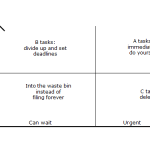Considerations on the meeting conditions Many meetings fail or become a breeding ground for conflict because the necessary clarifications have not been communicated in advance. Role, relationship Preconceptions about role, purpose and intentions remain hidden and lead to misunderstandings for others. What role am I acting in? What hat do I have on? The same […]
Author Archives: Leadion
4 dimensions of non-verbal communication
Overview Which is the most important skill in conversation? There are many varied answers to the question of which is the most important or central skill in communication (and hence also in leadership). Asking the right questions, the art of formulation, framing, structure and construction of conversations, attitude and view of humanity. One […]
Meta-Model of language
The term "inadequate productivity" (as a linguistic representation) will be understood in six different ways by six different members of staff, since they have six different experiences with it. In individual cases, the term "insufficient productivity" could also be hiding deeper structures (previous experiences, assumptions etc.) under its surface, which the individual is […]
You- message versus I- message
I-messages Sending I-messages. If expectations are not fulfilled, if I cannot accept certain behaviour or if I myself am in conflict with my partner, I can use "I-messages" to tell him that I am also a person with feelings, who is annoyed, disappointed, vulnerable. The I-message gives the other person information on how I am […]
Corkscrew Dialogue
Corkscrew Dialogues: Dive down beneath the visible surface of symptoms to the area of internal motivations, to bring old problems to the surface and air them Example: A woman arrives late. Her husband is ill and she had to take a child to the kindergarten […]
Contact/ Rapport
There are many idioms and sayings that describe what happens between two people who have a good connection: they can read each others minds, they have a direct line, they are on the same wavelength, they have a special chemistry, they sympathise etc. When this is the case, meetings, talks and negotiations – even […]
Der Status
Nach eine Unterlage von Jost Meyer (Schauspiellehrer) 1. Was ist Status? Der Begriff des Status in der hier gebrauchten Form wurde erstmals von Keith Johnstone im Rahmen seiner Theaterarbeit verwendet. Er ist ein nützliches Werkzeug für die Analyse und die Steuerung von Kommunikation. In erster Linie kennzeichnet er ein wahrnehmbares Verhalten einer Person gegenüber einer […]
Self- Coaching
1. Basic feelings Indication: Conflict in the system (family, career, group …) Goal: X wants to be able to behave more flexibly towards Y, in order to remove the feed from the conflict which is putting such a strain on X himself and the system. Method: […]
Eisenhower-Matrix
In order to cope with the large number of tasks in a working day, the first step must be to put these into some kind of order. Eisenhower’s matrix is an extremely effective technique for this. The tasks are sorted by two criteria, "importance" and "urgency". According to this, there are four […]





